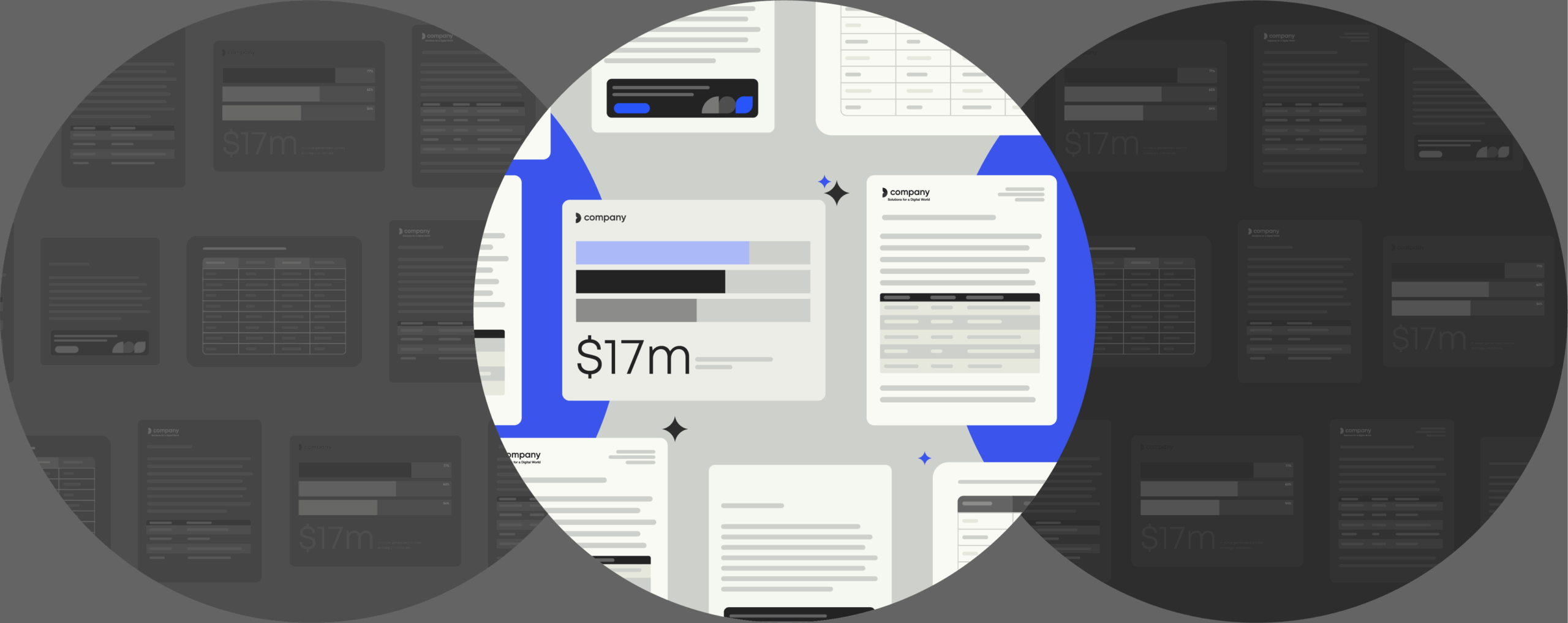Protect your brand and budget with digital asset management (DAM)

Content without control is wasted investment
Creating content is expensive.
Enterprises spend millions every year creating digital assets. But without a system to manage them, much of that investment goes to waste. Files get lost, work gets recreated, and outdated assets creep into client-facing work. And when brand control slips, it can hurt both your reputation and your revenue.
In fact, according to Adobe, one-third of expensive media assets go unused if there isn’t a good digital asset management (DAM) in place to make them visible and accessible across the enterprise.
That’s why more enterprises are turning to DAM platforms to scale and safeguard their content. DAM solutions keep assets findable, reusable, and compliant, so every piece of content continues to add value long after it’s created.
Digital asset management explained
Can’t-miss branding tips
Learn how to keep your brand consistent. Get ideas and examples to help your team create on-brand work with less effort.
First, what is a digital asset?
A digital asset is any digital file, like an image, video, audio clip, document, or piece of code, that holds value to an organization because of its rights, context, or purpose.
Not every digital file is a digital asset. What makes it an asset is the value it brings to the business: a contract has legal weight, a brand logo carries a company’s brand identity, and a product video drives revenue.
In other words, digital assets are files with recognized business value. They’re the building blocks of your brand, operations, and revenue.
Common types of digital assets include:
- Images: JPEG, PNG, GIF, TIFF, RAW
- Videos: MP4, AVI, MOV, WMV
- Audio: MP3, WAV, AIFF
- Documents: PDF, Word, Excel, PowerPoint
- 3D models and animations: STL, OBJ, FBX
- Web pages and code: HTML, CSS, JavaScript
What is digital asset management?
Digital asset management (DAM) is software that organizes, governs, and activates those valuable files from a central platform.
At its core, a DAM system acts as a library for valuable content within an enterprise. It also makes sure the right people can access and manage them, according to brand and compliance standards.
Many modern DAM solutions go further with add-on modules such as brand guidelines, project workflow management, and usage analytics. This could look like a marketer pulling a campaign image and instantly seeing the rules for how it can be used, or a designer submitting a new asset through an approval step before it goes live.
Ultimately, all of a DAM’s capabilities aim to solve the same purpose: to make sure organizations can manage their digital assets at scale.
Who uses DAM systems and why?
Digital assets touch almost every corner of a business. That’s why, for large enterprises, DAM systems are essential for any team that needs to keep content organized, easy to share, and safe to use at scale.
Here’s how different teams lean on DAM for control of their digital assets:
- Marketing: With a single library of approved assets, marketing ensures every region works from the same visuals, copy, and templates. That cuts down on rework and protects the brand.
- Sales: Quick access to the latest decks, proposals, and RFP responses means sales teams spend less time creating materials and more time with clients driving revenue.
- Creative: Version chaos stays under control when design files and approvals live in one place, letting creatives focus on producing content instead of tracking it.
- Legal and compliance: Centralized control of rights, licensing, and expiration dates reduces risk and guarantees only approved content makes it into client-facing work.
- IT: Scalability, governance, and integrations with CMS, CRM, and productivity platforms make DAM valuable to IT, keeping assets secure and aligned with the wider tech stack.
What’s the difference between DAM and cloud storage?
It’s easy to confuse a DAM with cloud storage platforms like Google Drive, Dropbox, or OneDrive. Both let you upload, store, and share files. But that’s where the similarities end.
Cloud storage is designed for simple file sharing. It works well for individuals or small teams but quickly falls short at enterprise scale. Folders get messy, version control disappears, and there’s no governance to ensure brand or compliance standards are upheld.
DAM systems are purpose-built for managing digital assets at scale. They go beyond storage by adding metadata for smarter search, permissions to control usage, and workflows to manage versions and approvals for multiple teams, markets, and regulatory environments.
Digital asset management
Key benefits of digital asset management
A DAM protects your content investment by keeping assets findable, reusable, and compliant. That means stronger brand control, lower risk of error and inconsistency, and higher ROI from every piece of content you create.
Here’s how that plays out in practice:
- Time savings through findability and reuse
Employees can locate the right file in seconds, and they don’t have to waste hours reworking or recreating content that already exists. That efficiency compounds across global teams and high-volume workflows. - Consistent brand execution
Marketing, sales, and regional offices all use the same approved visuals, typefaces, and templates. That consistency builds trust and protects brand reputation. - Collaboration without silos
One governed library means teams across offices and regions access the same approved materials, speeding up delivery and reducing duplication of effort. - Reduced compliance risk
Rights, expiration dates, and version history are tracked automatically, lowering the chance of legal issues or outdated content slipping into client-facing work. - Higher ROI from content
Assets continue to deliver value long after they’re created because they remain discoverable and ready to reuse. A DAM makes sure content investments generate returns instead of sitting idle.
Key features of digital asset management tools
Want to realize those benefits? You need a DAM platform with the right capabilities. On top of being a storage system, a DAM provides the structure and controls that make assets usable at enterprise scale.
Metadata tagging and search
Metadata is what makes assets findable. With tags for product names, campaigns, formats, or regions, teams can surface the right file in seconds instead of digging through folders. It’s like giving every asset a unique fingerprint—one that saves time and keeps projects moving.
Role-based access and permissions
Not everyone needs full control. DAMs let admins assign access by role, department, or project. Sales teams can download the latest deck, while only brand managers can update logos. It’s structured freedom: easy access without risking mistakes.
Integrations with creative and enterprise tools
A DAM works best when it connects to the tools people already use—Adobe Creative Cloud, Microsoft Office, project management platforms, and more. Designers can pull approved assets straight into Photoshop, while marketers drop them into PowerPoint. The DAM becomes part of the workflow, not another silo.
Versioning and approval workflows
No more guessing which file is the “real” final. DAMs track versions automatically, flagging the current approved asset while keeping past iterations for reference. Built-in approval workflows route content through the right reviewers, so only compliant, brand-ready files get published.
Audit trails and usage analytics
Every action leaves a trace. DAMs log who accessed what and when, while analytics reveal which assets are driving engagement and which are underused. For leaders, this is insight; for compliance teams, it’s peace of mind.
Common use cases for DAM
DAM systems sit at the centre of how enterprises create, share, and protect content at scale. Whether it’s keeping marketing campaigns consistent, ensuring compliance in regulated industries, or enabling global teams to work from the same playbook, DAMs provide the structure to manage content across every stage of the business.
Here are some of the most common ways enterprises put a DAM to work:
Marketing and brand teams
Marketing teams rely on a DAM to deliver campaigns consistently across channels. From social posts to OOH campaigns, everyone works from the same approved library.
Legal and compliance
For regulated industries, a DAM helps control licensing, usage rights, and expiration dates, reducing the risk of legal exposure.
Product and content lifecycle management
DAMs play a role throughout the content lifecycle, from creation to distribution to archiving. They ensure the latest product information is available to every channel.
Global teams and distributed workforces
Enterprises with regional offices or remote teams use DAMs to standardize brand application worldwide. Everyone works from the same source of truth, regardless of geography.
Choosing the right Digital Asset Management solution
A DAM system is a long-term investment. Once it’s in place, it becomes the backbone of how teams access, manage, and govern content. That’s why the buying decision isn’t just about features; it’s about choosing a platform that supports your business goals today and can adapt as those goals evolve.
Here are some areas to prioritize that reduce risk, protect your brand, and make teams more productive:
What to look for in a DAM platform:
- Governance and compliance: Strong metadata, versioning, and rights management
- Ease of use: A library employees will actually use, with intuitive search and workflows
- Integrations: Compatibility with creative tools, CMS, CRM, and productivity platforms
- Scalability: Ability to grow with your enterprise and handle increasing asset volume
- Analytics: Insights into usage, adoption, and content effectiveness
Questions to ask vendors:
- How does the DAM handle metadata, rights, and licensing at scale?
- Which integrations are native, and how do they support your current stack?
- What’s the process for version control and approvals?
- How easily can the platform roll out updates across global teams?
- What support and SLAs are offered post-implementation?
Where DAM systems fall short on governance
DAM systems may be excellent at storing and organizing assets at scale, but they only solve part of the problem. They don’t ensure those assets actually make it into document workflows, where business content gets created.
That’s the missing piece. A DAM might hold the correct logos, disclaimers, and campaign visuals, but it doesn’t automatically apply them to documents. That “last mile” of brand governance—how assets are applied at the point of creation—is where the real risk lies.
That’s exactly where document generation platforms like Templafy come in. Templafy pairs with DAM systems to close the governance gap by surfacing the right templates and assets directly inside workflows. The result: every document, presentation, and email is automatically built with the latest, compliant content, maximizing the value of the DAM while protecting the brand.
additional content
Make on-brand content the easiest choice for your team
Templafy’s content library integrates with Microsoft Office, protecting brand integrity and ensuring everyone can access compliant templates with a single click.
How Templafy solves for brand governance inside workflows
Templafy is an enterprise-grade document generation and content enablement platform that ensures every piece of business content—whether it’s a proposal, presentation, contract, or email—is on-brand, compliant, and up to date.
It works directly inside the tools employees use every day like, Microsoft Word, PowerPoint, Outlook, Excel, so governance doesn’t stop at the DAM. Instead, it flows into the actual workflows where business content is created.
Here’s how Templafy maximizes the value of a DAM:
- Direct DAM connections
Templafy integrates with leading DAMs like Bynder, Adobe Experience Manager, Brandfolder, Canto, Aprimo, and Sitecore. Employees no longer need to toggle between portals or manually download files, because assets surface automatically in Word, PowerPoint, and Outlook.
Read more about Templafy’s integrations - Smart templates and dynamic content
Governance is built in from the start. Every document and presentation begins with a brand-approved template, preloaded with the right fonts, styles, and disclaimers. Updates roll out across the enterprise instantly, eliminating the risk of outdated files in circulation.
Read more about Templafy’s dynamic templates - Always up to date
When a logo, compliance clause, or product detail changes in the DAM, Templafy reflects it immediately in templates and content libraries. Old assets disappear from workflows, ensuring only the most accurate, approved content is used. - A content library inside workflows
No more jumping between systems to create high-quality, brand complaint content. Templafy surfaces content right where employees are working, so compliance and speed go hand in hand. - AI with brand guardrails
Templafy’s AI capabilities allow employees to generate content faster, but always within brand and compliance rules. GenAI becomes a governance ally, helping teams work quickly without putting the brand at risk.
Read more about Tempalfy’s enterprise-grade GenAI
Why Templafy works for brand-driven enterprises
Pairing a DAM with Templafy means brand assets don’t just sit in storage, they get put to work. Every document, presentation, contract, or email is automatically filled with the latest content and assets that are always on-brand and up to date. That is governance you can see reflected in business results.
Here’s what that looks like in practice:
Enterprise-wide compliance
Protect your reputation and avoid costly mistakes. With Templafy, every document is accurate, current, and legally compliant by default, reducing brand and regulatory risk.
Swift brand rollouts
When the brand evolves, every piece of content evolves with it. Logos, disclaimers, and identities are updated instantly across workflows with no lag, no manual fixes, and no missed markets.
Time savings for everyone
Employees stop wasting hours searching for assets or fixing formatting. Templates and approved content surface instantly, freeing teams to focus on work that drives revenue.
GenAI with brand control
AI becomes an accelerator instead of a liability. Employees can generate content quickly while brand and compliance guardrails keep every output high quality and on brand.
A connected content ecosystem
DAM, CRM, CMS, and productivity tools no longer operate in silos. With Templafy as the connective layer, governance flows across the entire content lifecycle so the business extracts maximum value from every asset created.
CUSTOMER CASE: ERM
How ERM safeguards its brand reputation across 8,000 employees
“If we didn’t have Templafy, there’s no way we could’ve gotten all 8,000 employees to adopt our new templates and showcase our new identity to our clients.”
— Sarah Middleton, Brand & Marketing Communications Director, ERM
Rolling out a rebrand to 40+ locations worldwide is no simple task. Without the right system, there’s no way to ensure every proposal, report, and client document reflects the latest brand identity.
With Templafy, ERM gave every employee instant access to approved templates and assets inside their workflows. Rolling out the new brand was fast, controlled, and consistent across the entire organization.
Read the full story to see the impact on efficiency and brand reputation.
CUSTOMER CASE: BDO CANADA
How BDO Canada saved $1.65 in one year with document automation
“Last year, we generated over 120,000 documents through Templafy, saving us about $1.65 million.”
— Brion Hendry, Partner and Assurance Innovation Leader, BDO Canada
Before Templafy, BDO’s content was scattered across SharePoint and shared drives, with multiple versions in circulation and employees often creating their own templates. Finding the right file meant digging through emails or asking colleagues, wasting valuable time.
Now, employees access approved templates and brand assets directly inside the applications they use every day. Through integration with BDO’s DAM system, images and visuals surface instantly in PowerPoint, without ever leaving the workflow.
Read the full story to see how BDO Canada secured brand consistency and boosted document productivity.
Ready to control your brand reputation at scale with every document?
The best way to understand how Templafy works is to see it in action. A demo shows you exactly how your teams can create on-brand, compliant, and up-to-date documents without ever leaving the tools they use every day.
You’ll also see why more than 4 million users across 800 enterprise companies already trust Templafy to protect their brand reputation, speed up content creation, and make governance automatic.



